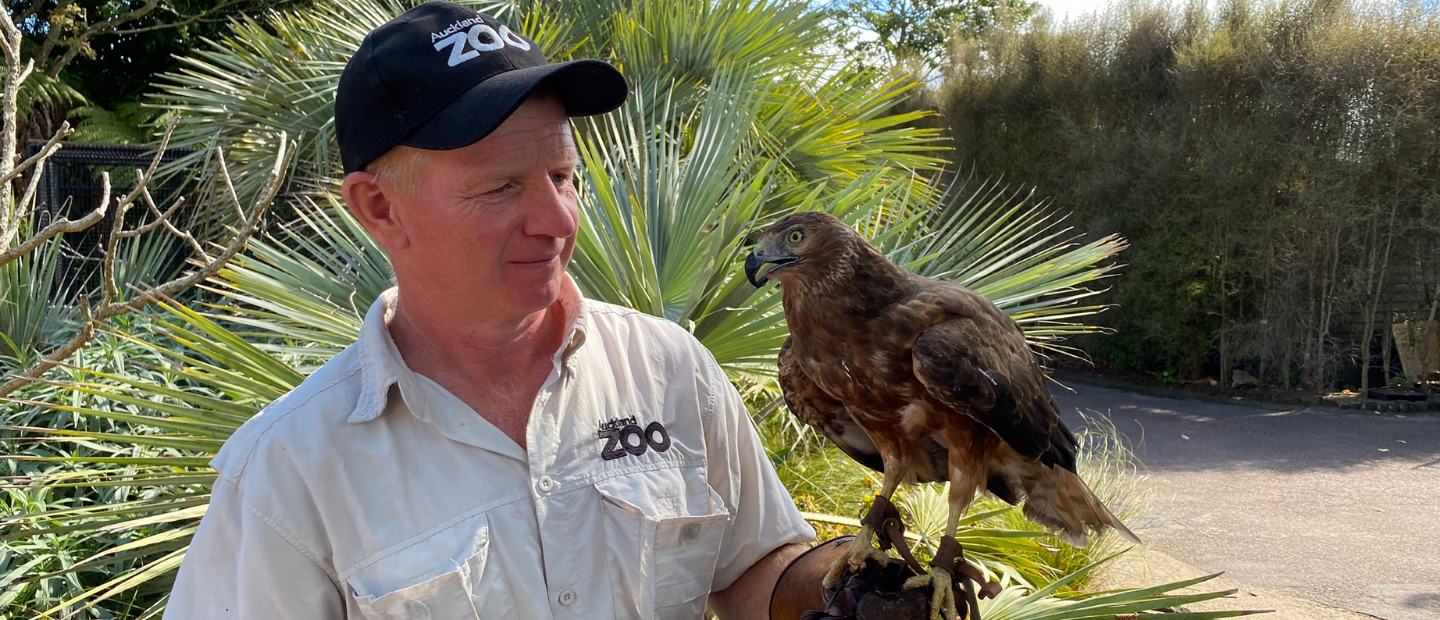The Auckland Zoo veterinary hospital treats a range of wild patients that often arrive incredibly sick or injured and are in urgent need of treatment. One such patient was a native kāhu (also known as a harrier hawk, swamp harrier or Australasian harrier) that was brought to Auckland Zoo in late 2020 for specialised veterinary care.
Arriving with a serious injury to her right eye, this kāhu also showed general weakness – a common sign of lead poisoning in birds of prey. To determine the cause of the bird’s condition, our vet team performed a range of tests which included radiographs, endoscopy, blood tests and eye exams carried out by an external specialist. The results of these tests confirmed she was permanently visually impaired in her right eye and had high levels of lead in her blood.
As our veterinary services manager James explains in our video below, lead poisoning affects how the nerves transmit signals, so the over-arching impression is that you have a weak lethargic bird. Left untreated, this toxic heavy metal will accumulate in the bird's body causing nervous system damage, organ failure and eventually leading to death.
Thankfully for this kāhu, our vet team were able to successfully treat her for lead poisoning – but this is an unlikely outcome for the majority of wild birds. “We can treat lead poisoning with a collation where we inject the patient with a medication that binds the lead that's in the blood and allows the bird to metabolize and excrete it. Of the many environmental toxins that are possible, at least with lead there is something we can do directly to counteract its effects. But obviously it would be much better if animals weren't affected by lead poisoning in the first place,” explains James.
Video
Rescued kāhu takes flight at Auckland Zoo!
We follow Jez as he tells the incredible story of a native kāhu (harrier hawk) that was successfully treated at the Zoo for toxic lead poisoning.
Many of New Zealand’s bird species are affected by lead poisoning, such as our endemic kea and kākā. These birds are able to easily find lead in their environment, as this metal is present in many buildings that were built prior to the 1990s. Lead can be found in materials such as nail heads, roof flashings and leaded paint, as well as in lead shot used by hunters and weights used by fishermen.
A study of urban free-ranging kākā in the Wellington region, carried out by Massey University researchers in 2017, discovered that ‘lead exposure is prevalent in this kākā population, with 43.2% of adults and 36.7% of nestlings with detectable blood lead concentrations.’ Researchers found that lead exposure was associated with reduced body condition in adult kākā, and behavioural changes were observed in an individual kea which had recorded the highest level of blood lead concentration within the study.
Similarly, studies carried out by our partners at the Department of Conservation (DOC) and Kea Conservation Trust (KCT) have found concerningly high blood-lead levels in kea that live close to human inhabited areas in Fiordland, South Westland, Aoraki Mt Cook, Arthur’s Pass and at Nelson plantation forestry sites.
Lead also enters the human food chain by being absorbed through the roots of plants and is especially of concern for young children, with the World Health Organisation stating ‘there is no level of exposure to lead that is known to be without harmful effects.’
You can help at home by replacing any old lead nails and flashings that you might have on your property and using fishing weights or ammunition that are lead-free. KCT have an initiative to help remove lead from areas of the South Island, which you can learn more about here.
Thankfully this kāhu is doing incredibly well post-treatment. Due to her permanent eye injury, she is unable to return to the wild, but has started an enriching new chapter of her life as an advocacy bird – engaging with our wonderful visitors and telling the story of the harmful effects of lead poisoning on New Zealand’s wildlife. You may have already seen her in our immersive Flight School experience with Jez and our animal experiences team. She is currently going through a seasonal moult so it will be several more weeks until she’s ready to spread her wings at Flight School again. “She’s currently taking a holiday to allow her to drop her old, tattered feathers and replace them with new ones. I’d describe it as a bit like going on a spa break and coming back a refreshed new you!” says Jez. So please keep an eye out when you visit the Zoo in the coming months.
It's thanks to your Zoo visits and support that enables our wildlife advocacy efforts. If you’d like to contribute further to the work of our veterinary team, you can donate here.


